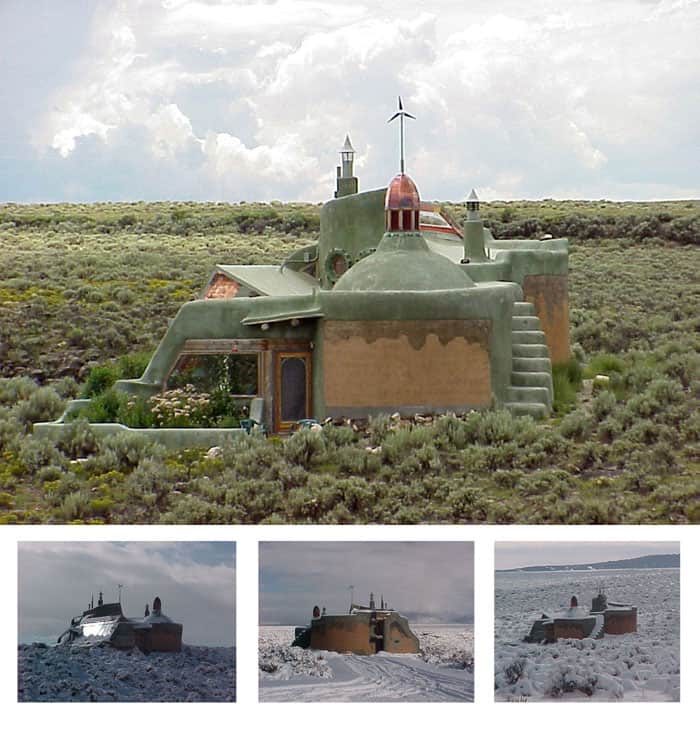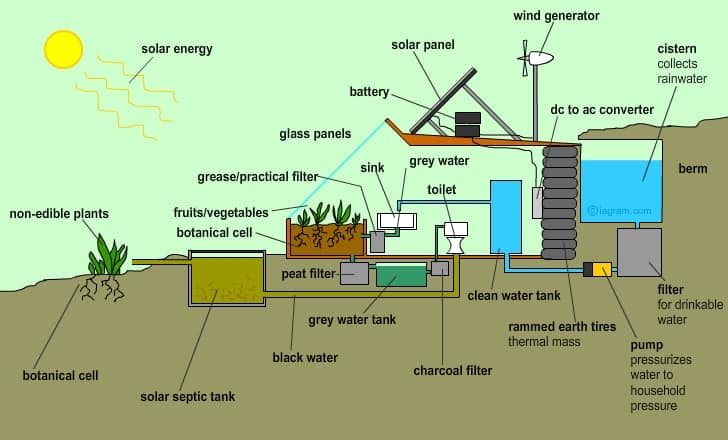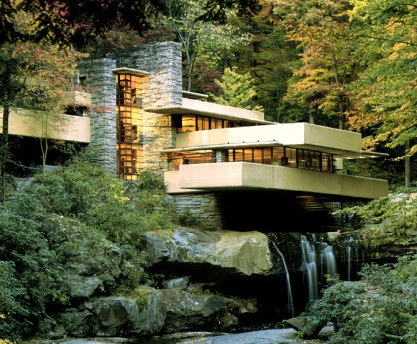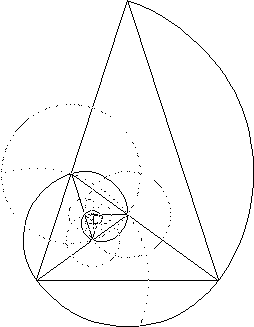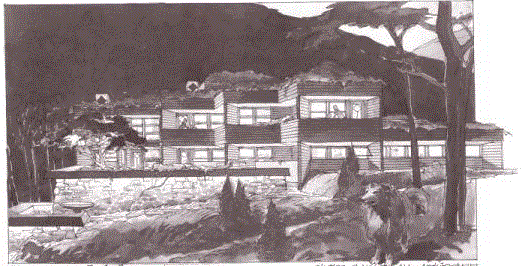I just read the book “A Natural System of House Design, An Architect’s Way” by Charles Woods. I was interested in it from Wood’s involvement with Malcolm Wells, a great natural architect and the pioneer of earth covered building.
Before I start my review I need to make clear that I see Woods as a fellow green builder and any critique I have is as one colleague to another. He is clearly an ally in my path of making the world a greener and healthier place.
In his book Woods sees himself more practical architect than Wells who has very strong but sometimes impractical views about ecology and how natural homes should be built. Woods says that Wells is, “stricter on this than I am. But I think I have come up with a reasonable compromise.”
And it shows in his architecture, which tends to be a lot more conventional from a systems point of view. I’m not talking visually but in terms of the materials specified (or more often not specified), the discussion of (or lack of) green systems like solar panels, gray water, composting, material recycling etc. and how they integrate into his designs.
Earthship
At one point he calls one of his house designs an Earthship and makes mention of another “environmental architect” who also calls his work an Earthship.
Woods writes,
“my houses have been looking more and more like ships of sorts. Why? Well…our houses really are like ships if you think about it. They do travel – not through sea or air, but through time and space.” But this shows Woods complete lack of understanding of an earthship.
The other architect is Michael Reynolds, a true natural builder and revolutionary thinker. To compare Reynold’s Earthships to his own work shows how ignorant Woods is of what defines an Earthship or a natural home. As an architect, and in my opinion like most architects, Woods is primarilly concerned with the visual aspect.
Throughout the book Woods is concerned with his “signature style” of design. For me this lacks the vision of what true green building is about. Yes green building can have a signature look. But green building is an acknowledgement of systems, the interconection of them and the impact they have on the planet.
If you look at Reynolds’ work it definitely has a very powerful style that is unmistakably “Reynolds” or “Earthship” but that is not what makes an Earthship.
An earthship can look however you want. The true definition of an Earthship is that it is made from local natural materials that have the lowest embodied energy possible and that it is off the grid in terms of gas, electricity, water and sewer. And in terms of food production to a large part too.
It is entirely defined by its systems and how they impact the environment. It has nothing to do with how it looks. In fact I wish the Earthships did have more great designers involved since they usually all look the same – they have a DIY weekender look. Which is of course because most of them are DIY buildings by the owners. And that is the genius of an Earthship. But that is another topic.
Woods Design
In terms of Woods book I enjoyed looking at the pretty drawings of houses. They are mostly rendered by the extremely talented Malcolm Wells. And when you combine Woods immaculate aesthetic you get some trully striking designs.
Frank Loyd Wright Influence
Woods is completely overwhelmed by Frank Loyd Wright’s style which isn’t a bad thing. The houses look beautiful. They are works of art even if they aren’t original. We would all benefit from a house designed by Woods.
But despite him saying that students of Wright “became little clones” and that Woods is “still overwhelmed, awed, and humbled” by Wright’s designs, Woods sees himself as having his own style unique from Wright. I see small differences in Woods’ work but overall they look like Wright designs to my untrained eye.
For example a design by Woods;
And the famous one by Wright:
Note: I am about to go on a long rant. And it may possibly be hard to follow – not because I am dealing with things above your head but because I don’t think I articulated it very well. Hopefully you can hang in there and not get too bored because it really is important stuff!
Architect as God
I had a hard time getting through Woods self importance. He constantly threw himself next to the great architects like Corbusier and Wright. As a teenager he says he was a “little prodigy.” Towards the end of the book he wraps up his perspective by quoting Ayn Rand’s fictional Architect and epitome of arrogance, Howard Roark from her book the Fountainhead, “I don’t build in order to have clients – I have clients in order to build.”
Green Builder Defined
I am a green builder. And as such have thought long and hard what my reason for building is. I have concluded that green building puts nature first. Period.
So anyone, including fellow green builders like Woods, who has an agenda other than putting the wellbeing of the planet first is not benefiting the planet (and thus humans as part of it) to their full potential and not technically fully a green builder in my eyes.
They may be a great builder and a wonderful human being. But I think it is important to own the definition of green builder. Hell, Woods doesn’t even call himself a green builder. He says he is a natural builder. But I think he would call himself a green builder too.
Woods’ attitude as an “Artist/Architect” with a capital “A” hampers his ability to be a true green builder. As long as his vision is more important than anything else the vision of the planet will always come second to him.
The Howard Roarks of this world with their purity of self expression and their laser sharp personal vision are isolated from the wholeness of the universe, in fact that may be their genius. Or you could argue they are taping into the greater universal energy.
Either way they are separating themselves from their earthly environment. As long as an Architect or Artist insists that “everything filter through my mind” first (as Woods puts it) before it becomes reality then they are claiming that they are the only and ultimate authority.
But no person is an island, regardless of your divine talent.
Although I suppose to us lesser mortals it is inspirational that these Artist/Architects have this talent, and I suppose like the pre-Martin Luther priests we know who to turn to if we want a conduit of Godly creation.
Me as Artiste
But as a person who was one of these Artists for over a decade, who lived and breathed the Roark inside me (I read the Fountainhead like a bible twice), who created great works of art that only my soul could create, I understand what it means to be driven by an inner truth.
It is an intoxicating state of mind. Your soul’s voice is the only voice you hear. You guard it like a precious jewel from the vulgar baseness of the world that is constantly trying to pull you into mediocrity.
And in so doing you separate yourself further and further from the world. You are a single shining light who gets it power from its own solitary divine source. And there is nothing wrong with this. Some of the greatest accomplishments in the world by humans came from this attitude.
But then things changed for me. I realized that the world needed me and that my actions, no matter how pure and honorable, were not helping the planet. I heard the planet’s SOS call and it pulled me to look outwards instead of always inwards.
Note: You are about half way through the rant. Congratulations and keep going!
Sebastian Bach Inspired
This is when I flipped from aspiring to be Mozart and started aspiring to be Bach.
Mozart was a Roark who like Woods could only create from their inner voice. As Woods says (arrogantly?), “I don’t think it is a matter of arrogance – it’s the only way I know how to work.”
But Bach was a lowly draftsman with a large family to feed. He was on meager salary by the church to churn out show tunes each week for the sermon, no more glorious or divinely inspired than the underpaid mason who built the beautiful cathedrals. Bach was a humble employee with a boss and a weekly deadline.
In his time nobody proclaimed him a genius. He was just the guy who helped put the weekly sermon together. Now I don’t know what Bach’s reason for being was. It is not important since it is speculation for me. I know little about the man. I’m just using him as a metaphor. To make my point I am going to make up his purpose and say that he wrote for others – for his boss, to feed his family.
And I think that is what a green builder does. They are servants to the planet. Their creative genius comes second to their devotion to improving the planet. I would actually say that is their creative genius but it is a selfless one.
I’m not saying the Artiste isn’t selfless. I would have died for my art. Nothing was more important than creation. My friends, myself, my family, the world, it all came second to my creative purpose. I sacrificed it all for the art. My point here is that the health of the planet was very low on my list of priorities.
Also, some people who don’t have the holistic vision of the universe – that we are all connected – would see this servant attitude of putting other things before personal creativity as failure.
For example you see it portrayed in the film Barton Fink, where a writer strugles with these very issues of inner vision vs. worldly corruption of that vision.
There is a scene in the movie when Fink the idealistic writer is explaining to the life hardened producer about wanting to write “something beautiful” with the screenplay. The producer, Lipnik, lays him out with the “hard truth”:
“You think the whole world revolves around whatever rattles inside that little kike head of yours? You think you’re the only writer that can give me that ‘Barton Fink’ feeling? I’ve got a HUNDRED writers that can give me that ‘Barton Fink’ feeling!”
But if you understand that we are all connected, that the flap of a butterfly does create storms on the other side of the planet, then you know that the most self preserving, self satisfying thing to do is to serve the whole with an understanding that you are not separate from it.
And even more importantly you can see that serving the whole and following your inner soul is one and the same.
There is no choice between one or the other. We are always doing both. The important thing, though, and this in my mind is really, really, important, is to understand you can’t do one without the other. To truly know it – and this can be a life long realization. It is the basis of most religions and how many enlightened people do you know? For most people becoming one with the universe is an elusive experience we may never have.
But just because you can’t see it doesn’t mean it isn’t there.
This was the source of Fink’s struggle and the producers hardness. They could not see the wholeness of the universe. They thought that self creation was separate from universal unity. And likewise does Woods and Roark.
Perhaps that view is their contribution to the world – their inability to see the whole? “It’s the only way I know how to work” as Woods says.
But I don’t think so. Regardless of our talents, we all have something to contribute in the grand scheme of things. From a universal point of view the mail carrier and the Mozart are all crucial. And to know that is to know we are all connected.
Focus On Our Connections
So the trick for me is not to worry about my talents but to focus on my connections – to the planet, my family, my neighbors, the air I breathe and the food I eat.
And to serve. It almost doesn’t matter what – Serve my family, my clients, my workers. Ultimately I hope it all goes to serving the planet and the universe. Ultimately I hope, in my limited understanding of how things work, that through serving I am served. Because an interconnected web always comes back to itself.
But as a green builder I serve first and foremost nature, with the understanding that both the oceans and my tap water, the Savannah of Africa and my close family are all part of the nature I serve.
I set out each day with this intention and over the course of a million decisions each day the question is always – which choice serves nature best?
Does this mean I piss my girlfriend off? My neighbors? Myself? Yes. Unfortunately. Regrettably. Embarrassingly.
My acts don’t always harmoniously balance the universal whole with loading the dishwasher in time. I tend to err in favor of some universal planetary savior thing, which ironically is due to me being self centered and forgetting that loading the dishwasher is just as much a part of the whole.
But my life is not over and I hope that as I mature I will improve the balance between immediately local needs like mortgages and more esoteric needs like saving rain forests I have never visited. Both are important.
Note: Congratulations you managed to wade through the entire rant. Now if you could comment below and tell me what I was trying to say that would be great because I lost myself about half way through. But I know it is important and would love for somebody to explain it to me.
Module System
Back to the book. Woods’ main point in the book is the connection between geometry and earth, and that nature is inherently geometric. He thus presents the Module System.
The module system is very simple: always design in measurements of 4 feet.
A room should be 12’x20′ and never 9’x23′. Always use increments of 4′. You can go smaller. A closet can be 2’x6′. But never 2.5’x5′. Like wise a house can be 32′ high but not 33′.
The reason for this, and I agree entirely, is that the module system forces the home to be inwardly symmetrical. Like our body, a seashell, a leaf, the house retains an inner harmony where all the parts resonate on the same linear language.
I think his choice of 4′ as the module foundation is a little random. I don’t know enough about nature’s measurements or sacred geometry to know if 4′ is any better than say 3′. Maybe we should be building along the Golden Triangle?
But either way if you stick to a modular foundation, and 4′ makes a lot of sense in today’s building since things are often in segments of 4′ – the 4’x8′ plywood for example – then you create an inner harmony. The 4′ foundation is also a hell of a lot easier than some of the more complex sacred geometry ratios.
Like a dew drop that holds itself together, the house will also hold itself together. There is an inner tension that holds all parts tegother. Without it the dew drop falls apart and becomes chaos. Without an innner harmony in a house it starts to look like a bunch of sticks and stones randomnly thrown together and it is painful to live in.
This modular system is both simple and genius and everything in the world should be built using a foundation grid.

